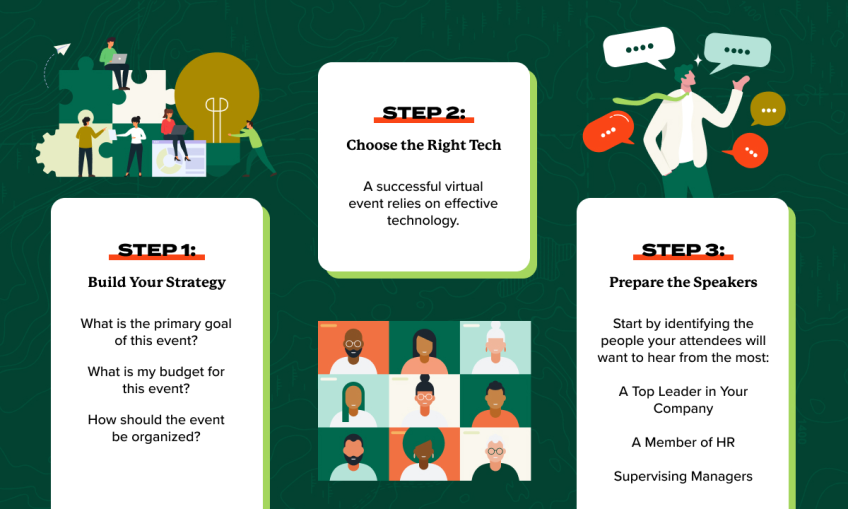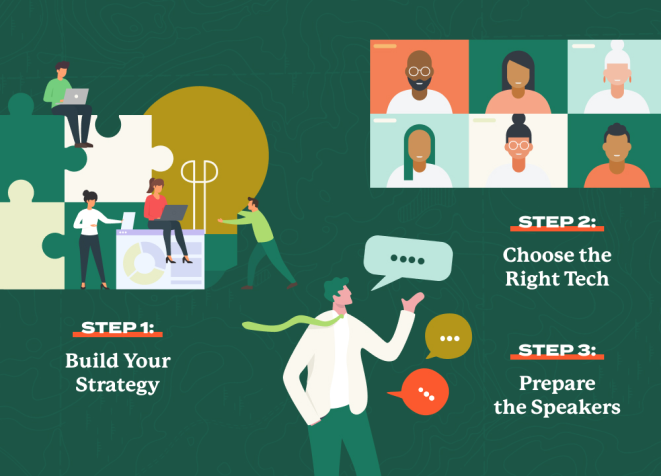
Finding the right hire for an open position has never been easy, but the circumstances of recent years have made it even more complex. Hiring managers across the U.S. are reporting difficulty finding people to fill jobs despite their best attempts to recruit new employees through career expos and job fairs.
This labor shortage is also reflected in recent data, with the U.S. Chamber of Commerce reporting 8.1 million job openings and 6.8 million unemployed workers in mid-2024. 1 This shortage has led many human resources departments to consider more competitive recruitment methods, such as hosting virtual hiring events, to get more candidates interested in their open career opportunities.
What Is a Virtual Hiring Event?
A virtual hiring event or job fair is an online event that allows employers to connect with and recruit potential employees for open positions. These events enable hiring managers to reach new candidates and showcase the benefits of working for their organization. By hosting the event virtually, organizations can reach a wider audience, including candidates who don’t live nearby or have responsibilities that make it difficult to attend an in-person event.
During a virtual job fair, the objective is to find excellent candidates to fill open positions in your organization. This will be potential employees’ first impression of the company, so it’s important to put every effort into planning a well-executed event. It’s recommended that planning begin three or more months before the event, depending on the number of candidates you’re hoping to attract.
Members of an HR team most often oversee the planning and implementation of virtual hiring events. However, these large-scale operations often require collaboration with other departments, including talent acquisition, marketing, communications, graphic design, finance, and the hiring managers of the teams with open positions. Keep this in mind during each stage of the planning process, as effective teamwork can significantly impact your event’s success.
How to Host a Virtual Job Fair
Virtual event planning may seem overwhelming at first, but by starting early and breaking it into smaller tasks, you can make the planning stages more manageable. No two hiring events are the same, but following the steps outlined below can help guide you through hosting your virtual job fair.
Step 1: Build Your Strategy
Begin at least three months before the job recruitment event by laying out your plan. If you’re working with a coworker to plan the virtual job fair, include them in this step. To build your strategy, ask yourself the following questions:
- What is the primary goal of this event?
- Hint:Make sure you set a SMART goal .
- What is my budget for this event?
- Which positions are currently available, and how many of each?
- How many candidates would we like to attend our event?
- What should be our event’s theme, if any?
- What is the date of the event?
- Hint:Make sure it doesn’t conflict with national or local holidays.
- How should the event be organized?
- What will the rough agenda look like?
- Which internal personnel will need to assist with this event?
Before moving on to the next step, ask 2-3 coworkers to review your strategy and provide feedback. They may add ideas you haven’t considered.
Earn a Graduate Certificate in Human Resources
View the online HR Management Certificate
Step 2: Choose the Right Tech
A successful virtual event relies on effective technology. It’s important to choose the platform you’ll use for your job fair early in the planning process so you’ll have plenty of time to add any necessary customizations and practice with the tool if it’s new to you. A few platforms commonly used for virtual events include:
- ClickMeeting : This online platform is designed for efficient collaboration, meetings and online communication
- Facebook Live : By going live from this social media platform, you can broadcast videos from wherever you are and allow your audience to participate via chat
- Livestorm : This video platform includes features designed to enhance audience engagement
- YouTube Live : Host a live event on the world’s largest video-sharing website to connect with a large audience in real-time
- Zoom : Utilize this virtual platform used to host meetings, webinars and events for customizable features such as Q&A, breakout rooms and screen sharing
When choosing which platform to use for your event, you may want to consider:
- Communication options such as chat and Q&A
- Ease of use for attendees
- Ease of use for presenters
- How to inform participants what platform you’re using
- Moderator control features, including the ability to mute or hide attendees and sensor comments
- Other technology needs, including cameras, microphones, and internet speed
- Presentation tools available
- Recording and transcription tools available
- Whether attendees and presenters will need to create an account or login
Step 3: Prepare the Speakers
Deciding which members of your organization should speak during your virtual hiring event is another important step in the planning process. Start by identifying the people your attendees will want to hear from the most:
- A top leader in your company: One person from your organization’s top leadership team should speak during your job fair, if only briefly. This could include the CEO, executive director, chief operating officer (COO) or another leader.
- A member of HR: A human resources team member should also be prepared to address the attendees. It’s important for this person to stress the benefits of working for your organization and to be ready to answer any questions candidates have about the open positions.
- Supervising managers: The managers who will be supervising the open positions should also be available during the event to speak with potential candidates. Depending on the number of open positions, this may be difficult. However, it’s important to have at least one person with specific knowledge about each position present at the event.
- An energetic emcee: The emcee can make or break your virtual job fair. Take great care in choosing the person (or people) who will act as the host and direct the order of events.
Once you have identified the people who will speak during your virtual hiring event, it’s important to make sure they’re prepared. Talk with each speaker at least two weeks before the event to make sure they understand their role, including how long they will speak and what they will talk about. Writing a loose script to help guide the event may be helpful.
Sample Agenda: Virtual Hiring Event
Welcome
The emcee(s) welcome attendees and provide an overview of what to expect from the event. (Time estimate: 3-5 min.)
Company Introduction
A member of leadership introduces the organization and gives a cursory overview of its history and objectives. (Time estimate: 5-7 min.)
Top Three Reasons to Apply
A member of the HR team summarizes the top three reasons to work for the company. Ideally, these three reasons will be based on feedback from current employees. (Time estimate: 5-7 min.)
Overview of Open Positions
A member of the HR team OR 2-3 supervising managers provide a brief overview of open positions. Include the title of each position, its 2-3 main responsibilities, and any prerequisites for employment. (Time estimate: 12-15 min.)
How to Apply
A member of the HR team provides an overview of the application process, including important links and required documents. Make sure attendees know what to expect from the organization’s application process. (Time estimate: 7-10 minutes)
Employee AMA
A panel of 3-5 current employees fields questions from the attendees during an “Ask Me Anything” session. Ideally, the panel will include employees with a mixture of experience levels. (Time estimate: 10-15 min.)
Pro tip: Prepare a list of questions in advance if attendees are quiet. Also, allow attendees to submit questions to a member of HR who can ask questions for them.
Small Groups
In small groups of 3-7 people, answer additional questions and engage in conversations to find out which candidates are most interested in the open positions and how they interact with current team members. (Time estimate: 20 min.)
Pro tip: Many virtual event platforms enable hosts to utilize “breakout rooms” and other features for small group discussions.
Step 4: Market Your Event
With the plans for your event set in place, it’s time to work on drawing a crowd. If your organization has a marketing and communications department, it’s important to collaborate with them during this step, as they have specialized expertise that will help you maximize the number of people who will learn about your event.
Depending on the jobs available in your organization, you may want to market directly to specific professional organizations, schools, community groups and other institutions. It’s essential to utilize a multi-channel marketing strategy that includes:
- Email communications
- Network outreach
- Paid advertisements
- Printed materials
- Social media marketing
Step 5: Follow Up with Candidates
This may be the most essential step to a successful virtual hiring event. By following up with candidates after the event, you can encourage them to apply for roles they’re interested in and open the communication channels in case they have additional questions. You can also ask attendees to complete a short evaluation so that you can learn about their experience during the job fair. Be sure to identify who in your organization will follow up with candidates, and if more than one person will be following up, ensure that they all share and request the same information.

Create a Positive Virtual Workforce
Gain more strategies to support the virtual workforce in Ohio University’s online Graduate Certificate in Human Resources Management . You’ll learn from experienced, supportive professors at OHIO’s AACSB-accredited College of Business and complete nine credit hours to earn this skills-focused credential. Upon completion of your certificate, OHIO can easily apply the credits you earned toward the online MBA , professional MBA or Master of Science in Management program if you wish to continue your graduate education.
At OHIO, you’ll join a diverse community of online students and study a curriculum designed to help you develop advanced skills for the modern business world. Learn more today.
Source
- Ferguson, Stephanie. “Understanding America’s Labor Shortage.” July 24, 2024. U.S. Chamber of Commerce. Retrieved August 2, 2024, from https://www.uschamber.com/workforce/understanding-americas-labor-shortage .
Infographic Transcript
On a dark-green background, the first three steps for planning a virtual hiring event are communicated through both words and graphics.
Step 1: Build Your Strategy
- What is the primary goal of this event?
- What is my budget for this event?
- How should the event be organized?
Step 2: Choose the Right Tech
A successful virtual event relies on effective technology.
Step 3: Prepare the Speakers
Start by identifying the people your attendees will want to hear from the most:
- A top leader in your company
- A member of HR
- Supervising managers
Your Future Starts Here
Call Us
740.924.5725
to speak with a knowledgeable Student Engagement Specialist.

